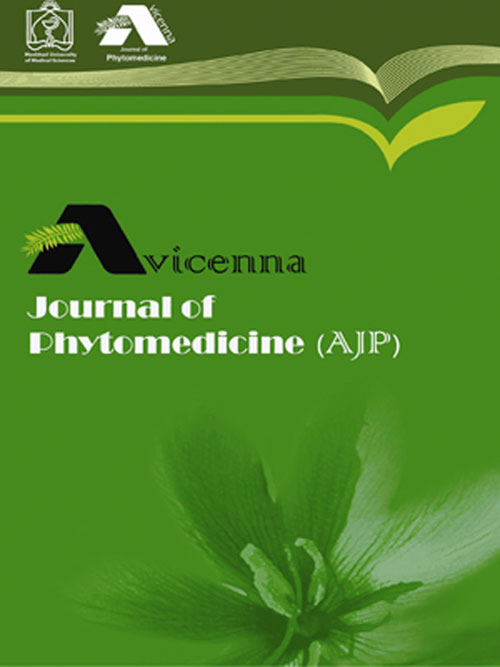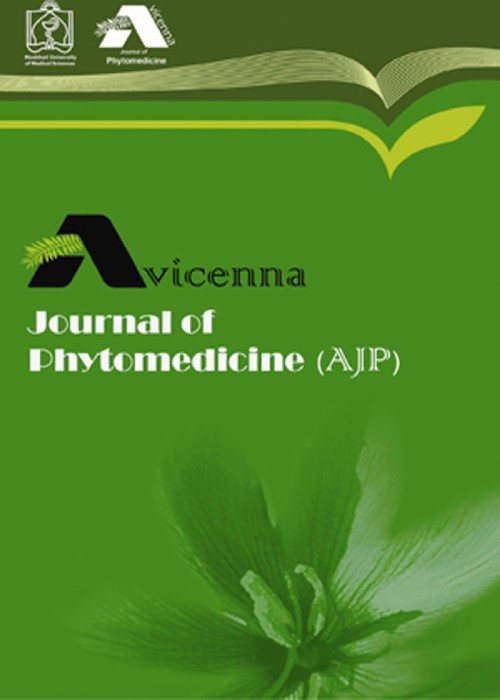فهرست مطالب

Avicenna Journal of Phytomedicine
Volume:12 Issue: 4, Jul-Aug 2022
- تاریخ انتشار: 1401/03/14
- تعداد عناوین: 9
-
-
Pages 337-345Objective
Gallic acid (GA) is an organic acid that possesses anti-inflammatory effects as it inhibits the production of metalloproteinases, tissue plasminogen activator, growth factors and adhesion molecules. Since formation of abdominal surgery-induced adhesion bands is accompanied by inflammation, angiogenesis and cell proliferation, in the current study, we assessed potential beneficial properties of GA against adhesion bands formation in rats.
Materials and MethodsThirty-six adult male rats were assigned into six groups of six animals. After induction of anesthesia, peritoneal injury was induced using a standard method and animals received either GA (10, 25, 50 and 100 mg/kg), or normal saline, while a group of rats remained intact. Seven days after the surgery, animals were decapitated and samples were collected for pathology evaluations. Also, lipid peroxidation (TBARS) and tumor necrosis factor alpha (TNF-α) levels were determined in serum samples.
ResultsOur results showed that GA significantly reduced lipid peroxidation in serum samples but had no effect on TNF-α levels. Furthermore, microscopic and macroscopic injuries reduced significantly in GA-treated animals.
ConclusionSince GA reduced adhesion bands formation at microscopic and macroscopic levels, it could be considered a treatment against adhesion bands formation.
Keywords: Gallic acid, Adhesion bands, TNF-α, Lipid Peroxidation -
Pages 346-356Objective
Osteoarthritis is the most common disease in the group of joint diseases, and its incidence is directly related to aging. Given the anti-inflammatory effects of curcumin as an active ingredient of turmeric, we aimed to investigate the effects of this compound in a new curcumin nanomicelle formula named SinaCurcumin® on the expression of microRNAs (miRNAs) involved in immune responses of patients with osteoarthritis.
Materials and MethodsWe divided 30 patients with osteoarthritis into two groups namely, nano curcumin-receiving (15 patients) and placebo-receiving (15 patients) and we studied them for 3 months. The Iranian Registry of Clinical Trials (IRCT) approved our study with the IRCT registry No. IRCT20151028024760N4. We evaluated the rates of the expression of microRNAs 146, 155, 16, and 138 employing SYBR Green Real-Time PCR method.
ResultsThe expression of miRNAs 155, 138, and 16 revealed a significant reduction in the curcumin-receiving group (p=0.002, p=0.024 and p=0.0001 respectively).
ConclusionOur research data indicated that the consumption of curcumin in patients with osteoarthritis could affect the immune system partially via altering the expression of microRNAs and cytokines.
Keywords: Curcumin, MiR-146, MiR-15, MiR-138, MiR-16, Osteoarthritis -
Pages 357-370Objective
The kidney is well-known as the vital organ which is responsible for maintaining body homeostasis and secretion of toxic metabolites. Renal injury is accompanied by oxidative stress which results in cellular apoptosis, lipid peroxidation, and reduction of antioxidant levels. Plant extracts and their phytoconstituents, owing to free radical scavenging properties, seem to be valuable against modern synthetic and chemical drugs. Naringin is a flavonoid present in citrus fruits with pharmacologic effects including antioxidant, anti-inflammatory, and anti-apoptotic properties. This review summarizes the renoprotective effects of naringin and discusses mechanisms of its action against renal injury.
Materials and MethodsFor this paper, original subject-related articles published up to October 2020 have been reviewed in the databases, including PubMed, Scopus, and Web of Science, and Google Scholar.
ResultsNaringin increases antioxidant enzyme activity, and glutathione content, reduces lipid peroxidation and inhibits inflammatory cytokines. In the molecular investigation, naringin activates the Nrf-2 signaling, prevents apoptosis signaling, and inhibits the autophagy pathway. Besides, naringin could protect the kidney through modulating microRNA-10a in the kidney tissue in an acute kidney injury model.
ConclusionThis review recommends that naringin can be considered a promising candidate to treat kidney dysfunction induced by oxidative stress in the future.
Keywords: Kidney, Naringin, Oxidative stress, Toxicity -
Pages 371-387Objective
Neurodegenerative diseases are considered an important cause of cognitive deficit and morbidity in old ages. Alzheimer’s disease (AD) is one of these disorders affecting about 40 million people in the world at the present time. Available drug therapy is mostly symptomatic and does not modify or stop disease progression. Recently, biologically active chemicals from herbs have been studied to develop new therapeutic drugs. Carvacrol has shown positive properties on many neurological diseases. This compound is expected to have the ability to affect AD pathogenesis and therefore, it is considered an anti-AD agent.
Materials and MethodsThis review was conducted using PubMed, Google Scholar and Science Direct bibliographic databases until November 2021. For data collection, the following keywords were used: carvacrol, neuroprotective, cognition, anti-inflammatory, antioxidant, Acetylcolinesterase inhibitor (AChEI), Alzheimer's, Parkinson’s, epilepsy, stroke, ischemic brain injury, and neurodegenerative diseases.
ResultsThis review summarizes in vitro and in vivo studies on protective potential of carvacrol in neurodegenerative disorders and various underlying mechanisms, such as anti-inflammatory, antioxidant, and anticholinesterase effects.
ConclusionWe gave an overview of available literature concerning neuroprotective effects of carvacrol in ameliorating the neurodegenerative diseases symptoms in vivo and in vitro. Particular attention is given to AD. Several neuro-pharmacological actions of carvacrol have been summarized in the current review article including anti-inflammatory, antioxidant, and AChEI properties.
Keywords: Carvacrol, Alzheimer’s disease, Neurodegenerative, Neuroprotection -
Pages 388-400ObjectiveIn the present study, the hepatoprotective effects of β-myrcene (MYR) on acetaminophen-induced hepatotoxicity were investigated.Materials and MethodsA total of 40 Balb/c mice were randomly divided into five groups as follows: 1) Normal control group which received only carboxymethylcellulose (CMC), the vehicle used to dissolve acetaminophen (N-acetyl-p-aminophenol, APAP, paracetamol) and MYR; 2) APAP group which received a single dose of acetaminophen (250 mg/kg) orally on day 7; 3) Silymarin group which received 200 mg/kg/day of silymarin; and 4 and 5) pretreatment groups in which, mice were treated with 100 or 200 mg/kg/day of MYR. Liver and blood samples were collected to analyze serum aminotransferases, inflammatory response, oxidative stress markers, and histopathological insults.ResultsOur results showed that MYR pretreatment attenuated liver damage and restored liver cells function and integrity as it decreased the leakage of serum aminotransferases (alanine and aspartate aminotransferases (ALT and AST, respectively)) into the blood (p<0.01). MYR treatment also reduced levels of myeloperoxidase (MPO) activity and nitric oxide (NO) (p<0.001). In addition, MYR pretreatment demonstrated significant antioxidant activity by decreasing malondialdehyde (MDA), reactive oxygen species (ROS), and reduced glutathione (GSH) levels (p<0.001). Furthermore, it restored the hepatic level of superoxide dismutase (SOD), catalase (CAT), and oxidized glutathione (GSSG) (p<0.001).ConclusionFor the first time, our results showed that MYR treatment significantly improved liver function by reducing oxidative stress and the inflammatory response induced by APAP.Keywords: β-myrcene, Antioxidants, Acute hepatic failure, Liver diseases
-
Pages 401-413ObjectiveThis study was conducted to investigate the antinociceptive and anti-inflammatory effect of ethyl acetate fraction of Oenothera rosea (EAOr) and the mechanism involved, in mice.Materials and MethodsThe antinociceptive activity was tested using chemical- and heat-induced nociception models. The anti-inflammatory activity was tested using carrageenan-induced edema and inflammatory cytokines were measured.ResultsEAOr reduced the licking time on the second phase of the formalin test (100 and 177 mg/kg). The antinociception of EAOr was prevented by L-NAME (10 mg/kg), 1H-[1, 2, 4]-oxadiazolo [4, 3-a]-quinoxalin-1-one (ODQ, 0.1 mg/kg), glibenclamide (10 mg/kg) and bicuculline (1 mg/kg), but not by naloxone (2 mg/kg). Also, EAOr decreased licking time in capsaicin induced-nociception. EAOr did not have effect on withdrawal latency in tail-flick test. Carrageenan-induced paw edema was reduced by EAOr, and TNF-α and IL-1β levels were reduced in mice treated with EAOr by 72.2 and 32.8%, respectively. Furthermore, EAOr did not present side effects as sedation nor gastric injury. Chemical analysis of this fraction showed the presence of glycosylated quercetin derivatives such as quercetin glucoside and quercetin rhamnoside in a 2.5% concentration.ConclusionThis study demonstrates antinociceptive and anti-inflammatory effect of an organic fraction of O. rosea and its possible interaction with the NO-cGMP-K+ channels and GABAergic system and thus, it could be considered a therapeutic alternative.Keywords: Oenothera rosea, Nociception, Inflammation, GABA, Nitric oxide, cGMP
-
Pages 414-424Objective
Comparative effect of Curcuma longa (C. longa) ethanolic extract and curcumin on paraquat (PQ)-induced systemic and lung oxidative stress and inflammation were evaluated in the present study.
Materials and MethodsControl animals were exposed to normal saline and PQ group to 54 mg/m3 PQ aerosols (8 times, each time for 30 min). Treatment groups were exposed to PQ and treated with 150 and 600 mg/kg/day C. longa, or 30 and 120 mg/kg/day curcumin after PQ exposure period for 16 days. Total and differential white blood cells (WBC) and oxidative markers were measured both in bronchoalveolar lavage (BALF) and blood at the end of the study.
ResultsTotal and differential WBC counts as well as malondialdehyde (MDA) level were significantly increased but total thiol content and the activities of catalase (CAT) and superoxide dismutase (SOD) were reduced in both the BALF and blood of the PQ group in comparison with the control group (p<0.05 to p<0.001). Both doses of C. longa and curcumin diminished MDA level, total and differential WBC counts in the blood and BALF but increased CAT and SOD activities in both of them compared to PQ group (p<0.05 to p<0.001). The effects of C. longa and curcumin high dose on most variables were markedly more than low dose (p<0.05 to p<0.001). Furthermore, the effects of curcumin on some variables were markedly more than C. longa (p<0.05 to p<0.001).
ConclusionBoth C. longa and curcumin improved PQ-induced systemic and lung inflammation and oxidative stress, but the effect of curcumin was more prominent.
Keywords: Paraquat, Curcuma longa, Curcumin, Oxidative stress, Inflammation, Lung, WBC -
Pages 425-438Objective
Hepatic encephalopathy (HE) is a serious neurological syndrome which is caused by acute and chronic liver diseases. In this study, the effect of gallic acid (GA) as an activator of AMP-activated protein kinase (AMPK) on memory and anxiety-like behaviors in rats with HE caused by bile duct ligation (BDL) was investigated.
Materials and MethodsThe rats were randomly divided into the following eight groups (n=7): sham; BDL; BDL+GA 20 mg/kg; BDL+GA 30 mg/kg; sham+dorsomorphin or compound C (CC) (as AMPK inhibitors); BDL+CC; BDL+GA 20 mg/kg+CC; and BDL+GA 30 mg/kg+CC. The rats received GA once daily by gavage for four weeks, and dorsomorphin 6.2 µg per rat was administered on a daily basis via bilateral intraventricular injection for four weeks. Behavioral tests including novel object recognition (NOR), open field and Morris water maze (MWM) were used to evaluate anxiety and memory in the rats.
ResultsExamining some parameters of NOR and MWM tests showed that memory performance was significantly reduced in the BDL versus the sham group, and in the BDL+CC versus the sham+CC group (p<0.05). GA intake improved memory in the GA-receiving groups compared with the BDL and BDL+CC groups (p<0.05). Examining some parameters of open field test showed that anxiety was significantly increased in the BDL versus the sham group, and the BDL+CC versus the sham+CC group (p<0.05). GA intake reduced anxiety in GA-receiving groups compared with the BDL+BDL+CC group (p<0.05).
ConclusionGA was effective in improving cognitive and anxiety-like behaviors through activating AMPK.
Keywords: Gallic acid, Bile duct ligation, Hepatic encephalopathy, AMPK activation, Memory -
Pages 439-448Objective
The clinical use of tacrolimus is limited due to its side effects. This research investigated the protective activities of pomegranate seed oil (PSO) against TAC toxicity.
Materials and MethodsThe groups are included normal (1 ml of corn oil), TAC (2 mg/kg), and co-treatment of PSO (0.4 and 0.8 ml/kg) and TAC. All administrations were carried out intraperitoneally for 14 days. After the last injection, blood was collected from the heart.
ResultsTAC increased creatinine and urea. Increased malondialdehyde, reduced thiol content and superoxide dismutase. The elevation of lactate dehydrogenase, aspartate aminotransferase (AST), alanine aminotransferase (ALT), creatinine kinase-MB and creatinine phosphokinase that confirmed cardiac toxicity. PSO reduced TAC toxicity. PSO decreased TAC-induced pathology injury.
ConclusionPSO reduced TAC toxicity in renal and heart via scavenging free radicals.
Keywords: Pomegranate seed oil, Tacrolimus, Nephrotoxicity, Cardiotoxicity


